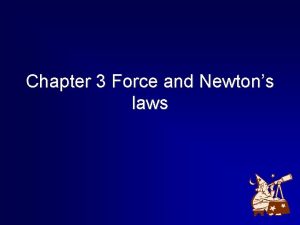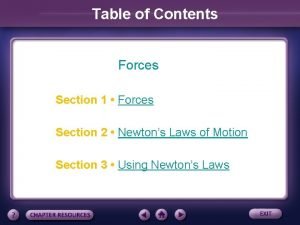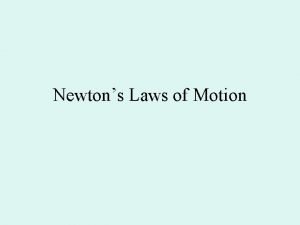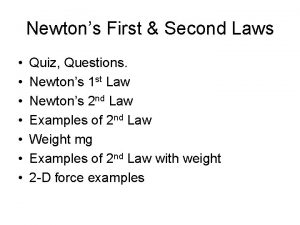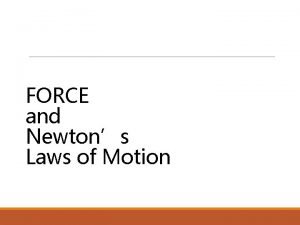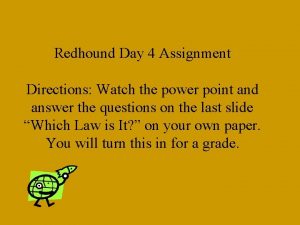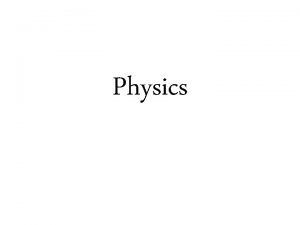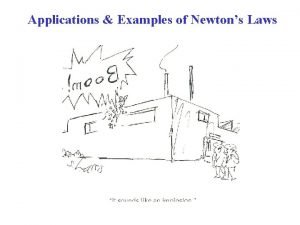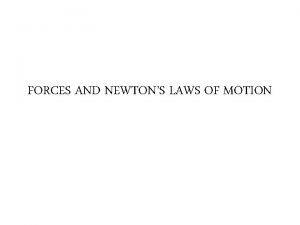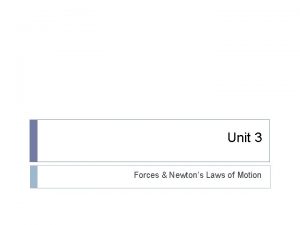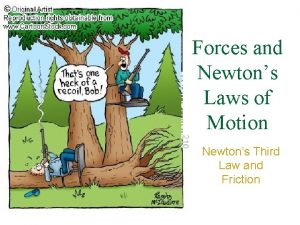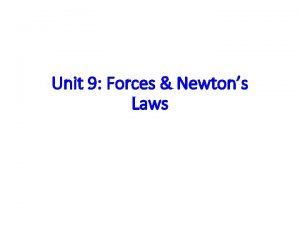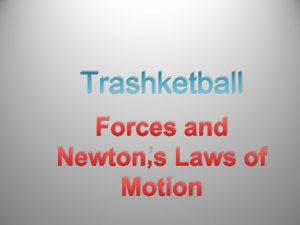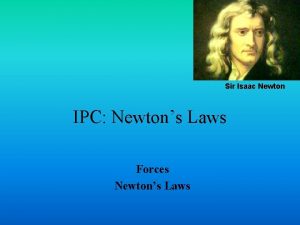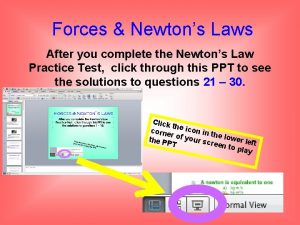Applications Examples of Newtons Laws Forces are VECTORS















- Slides: 15

Applications & Examples of Newton’s Laws

• Forces are VECTORS!! • Newton’s 2 nd Law: ∑F = ma ∑F = VECTOR SUM of all forces on mass m Need VECTOR addition to add forces in the 2 nd Law! – Forces add according to rules of VECTOR ADDITION! (Ch. 3)

• Newton’s 2 nd Law problems: • STEP 1: Sketch the situation!! – Draw a “Free Body” diagram for EACH body in problem & draw ALL forces acting on it. • Part of your grade on exam & quiz problems! • STEP 2: Resolve the forces on each body into components – Use a convenient choice of x, y axes • Use the rules for finding vector components from Ch. 3.

• STEP 3: Apply Newton’s 2 nd Law to EACH BODY SEPARATELY: ∑F = ma Notice that this is the LAST step, NOT the first! – A SEPARATE equation like this for each body! – Resolved into components: ∑Fx = max ∑Fy = may

Conceptual Example Moving at constant v, with NO friction, which free body diagram is correct?

Example Particle in Equilibrium “Equilibrium” ≡ The total force is zero. ∑F = 0 or ∑Fx = 0 & ∑Fy = 0 Example (a) Hanging lamp (massless chain). (b) Free body diagram for lamp. ∑Fy = 0 T – Fg = 0; T = Fg = mg (c) Free body diagram for chain. ∑Fy = 0 T – T´ = 0; T´ = T = mg

Example Particle Under a Net Force Example (a) Crate being pulled to right across a floor. (b) Free body diagram for crate. ∑Fx = T = max ax = (T/m) ay = 0, because of no vertical motion. ∑Fy = 0 n – Fg = 0; n = Fg = mg

Example Normal Force Again “Normal Force” ≡ When a mass is in contact with a surface, the Normal Force n = force perpendicular to (normal to) the surface acting on the mass. Example Book on a table. Hand pushing down. Book free body diagram. ay = 0, because of no vertical motion (equilibrium). ∑Fy = 0 n – Fg - F = 0 n = Fg + F = mg + F Showing again that the normal force is not always = & opposite to the weight!!

Example 5. 4: Traffic Light at Equilibrium (a) Traffic Light, Fg = mg = 122 N hangs from a cable, fastened to a support. Upper cables are weaker than vertical one. Will break if tension exceeds 100 N. Does light fall or stay hanging? (b) Free body diagram for light. ay = 0, no vertical motion. ∑Fy = 0 T 3 – Fg = 0 T 3 = Fg = mg = 122 N (c) Free body diagram for cable junction (zero mass). T 1 x = -T 1 cos(37°), T 1 y = T 1 sin(37°) T 2 x = T 2 cos(53°), T 2 y = T 2 sin(53°), ax = ay = 0. Unknowns are T 1 & T 2. ∑Fx = 0 T 1 x + T 2 x = 0 or -T 1 cos(37°) + T 2 cos(53°) = 0 (1) ∑Fy = 0 T 1 y + T 2 y – T 3 = 0 or T 1 sin(37°) + T 2 sin(53°) – 122 N = 0 (2) (1) & (2) are 2 equations, 2 unknowns. Algebra is required to solve for T 1 & T 2! Solution: T 1 = 73. 4 N, T 2 = 97. 4 N

Example

Example 5. 6: Runaway Car

Example 5. 7: One Block Pushes Another

Example 5. 8: Weighing a Fish in an Elevator

Example 5. 9: Atwood Machine

Example 5. 10 Inclined Plane, 2 Connected Objects
 Antigentest åre
Antigentest åre Newton's law
Newton's law Acceleration due to gravity
Acceleration due to gravity Newton's 3 law
Newton's 3 law Third law of newton
Third law of newton Section 3 using newtons laws
Section 3 using newtons laws Section 3 using newtons laws
Section 3 using newtons laws Section 3 using newtons laws
Section 3 using newtons laws Newtons laws od motion
Newtons laws od motion What are newtons 3 laws
What are newtons 3 laws Section 2 newtons laws of motion
Section 2 newtons laws of motion Newton's first and second law quiz
Newton's first and second law quiz Newton's 3rd law example
Newton's 3rd law example Motion examples in everyday life
Motion examples in everyday life Newtons laws
Newtons laws 3 law of newton
3 law of newton





